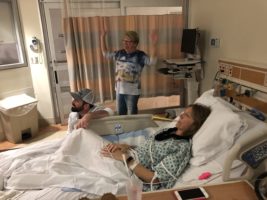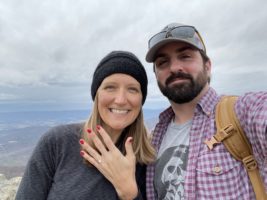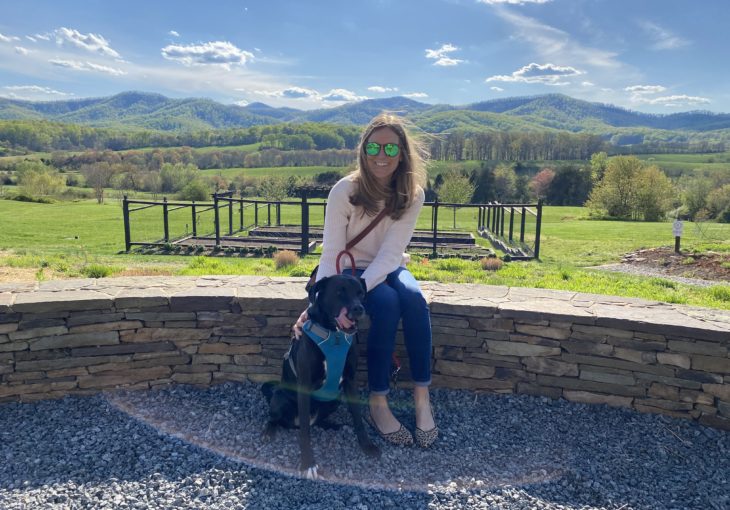By: Katelyn Shull and Mary Gordon
The Saturday before Christmas 2019, Mary woke up feeling “off”. Throughout the morning she felt more tired than usual and found herself sitting down to rest several times while hanging Christmas decorations in her Falls Church, VA home. She mustered the energy to meet a friend for a planned shopping trip in the city. Several hours into the shopping trip, Mary rounded a corner and suddenly everything went dark for a split second. She leaned over and put her hands on her knees, afraid she was about to pass out. The feeling was like nothing she’d ever experienced. However, after the moment passed, she felt fine and continued with her day, thinking maybe she was dehydrated and needed a good night’s sleep.
Over the next week, these episodes of near syncope happened 3 more times. While having dinner with friends on December 30th, it happened again and fearing it was related to her heart, she decided it was time to see a doctor. She had plans to embark on a vacation to visit family on January 1st, so she scheduled an appointment as soon as she woke up the next morning to ensure it would be safe to travel the next day.
She was lucky to get an appointment on New Year’s Eve, but her regular doctor was off for the holiday, so she saw a physician’s assistant (PA). The PA took an EKG and everything looked similar to the last one she had two years ago, but her blood pressure was abnormally high. The PA told Mary not to travel the next day and wanted her to wear a holter monitor, a portable monitor that continuously measures the heart’s electrical activity, and have some bloodwork done. This is where Mary’s memory of the event ends…
While waiting for the elevator to take her to the lab on the lower floor of the office, Mary had cardiac arrest. Luckily, the receptionist heard her labored breathing and sprang into action by running to check on Mary and calling for help. The PA who examined Mary, along with another doctor, performed CPR for 6 minutes and delivered two shocks from an AED. The second shock sent Mary’s heart back into a normal rhythm and she was told she woke up screaming at this point, though she has no memory of this or the ambulance ride to the hospital.
Mary’s first memory is in the ER, when she looked over and recognized her boyfriend standing at the foot of her bed beside several doctors, his eyes wide and fearful. “What are you doing here?” she asked him. Mary had no memory other than the initial exam by the PA but knew she was in the hospital. She’s told that she repeated herself, asking over and over why she was in the hospital. Even now she doesn’t remember much about spending New Year’s Eve in the hospital. Her family by her side, Mary watched the Times Square ball drop from her hospital bed in the cardiac ICU, complete with party favors delivered by the nurses.
standing at the foot of her bed beside several doctors, his eyes wide and fearful. “What are you doing here?” she asked him. Mary had no memory other than the initial exam by the PA but knew she was in the hospital. She’s told that she repeated herself, asking over and over why she was in the hospital. Even now she doesn’t remember much about spending New Year’s Eve in the hospital. Her family by her side, Mary watched the Times Square ball drop from her hospital bed in the cardiac ICU, complete with party favors delivered by the nurses.
As a healthy 37-year-old, doctors weren’t sure why Mary’s heart went into ventricular tachycardia leading to cardiac arrest. She was told there was a less than .1% chance that it was related to mitral valve prolapse, a hereditary condition Mary was diagnosed with while she was in college. Her first and only visit to a cardiologist was just two years before the event and she was told her MVP was mild – a 2 out of 10 – and to come back if she had symptoms. On her third day in the hospital, as is protocol for cardiac arrest patients, Mary had surgery to implant a subcutaneous implantable cardioverter defibrillator (S-ICD). After multiple cardiac tests over the next few days, it was found that her mitral valve prolapse was more severe than originally suspected and surgery was scheduled to repair the valve.
The night before surgery, Mary felt nervous but refused to do any research and trusted that she was in good hands. The surgery was a “mini” mitral valve repair, meaning minimally invasive, and was performed through a small incision on her side instead of a much larger sternal incision. The surgeon found there was no need to repair the leaflets of the valve and opted for annuloplasty, a procedure to reinforce the ring around the valve by sewing in a band, believing this would prevent further prolapse and reduce the chance of arrythmia.
When it was finally time for Mary to be discharged on January 14th, she felt nervous and anxious to go home and leave the constant care and supervision of the hospital environment, but having the ICD gave her and her family peace of mind. Mary had a great support system when arriving back home, which she is extremely thankful for because recovery was harder than she anticipated. She was often tired, exhausted after walking just a few steps, and struggled with visual disturbances related to migraine headaches. Mary was excited to learn about cardiac rehab where she could build strength and get back to being active while being monitored. She loved the social aspect of being around people who had been through similar cardiac events and the comfort of knowing nurses would be watching her heart rate while she exercised for the first time after surgery. Rehab started in late February, but she was only able to go a few times before it shut down due to Covid-19 in March. Mary didn’t let this stop her and set goals for herself to keep moving. She walked miles and miles in her neighborhood with her dog, Almond, staying active until she finally went back to rehab when it opened in June. She graduated in September and continues setting exercise goals and getting stronger.
On New Year’s Eve 2020, exactly one year after Mary’s cardiac arrest, she and Matt took the day off work to celebrate her one-year “heart-iversary”. She wanted to prove how far she’d come in the past year by hiking her favorite trail in Shenandoah National Park. At the top of the trail, Matt proposed, and the two are now happily engaged. Today Mary is 39 years old and continues her recovery with support from friends and family, a focus on exercise and a different outlook on life. She stays in touch with the wonderful PA who happened to be working on New Year’s Eve and jumped into action to save her life.
the day off work to celebrate her one-year “heart-iversary”. She wanted to prove how far she’d come in the past year by hiking her favorite trail in Shenandoah National Park. At the top of the trail, Matt proposed, and the two are now happily engaged. Today Mary is 39 years old and continues her recovery with support from friends and family, a focus on exercise and a different outlook on life. She stays in touch with the wonderful PA who happened to be working on New Year’s Eve and jumped into action to save her life.
Mary wants to share her story to remind others to listen to their body and take action when something doesn’t seem right. Cardiac arrest can happen to anyone at any time and she strongly wants people to know how to perform CPR and increase awareness of AED placement.
